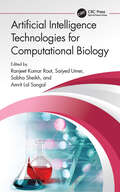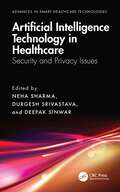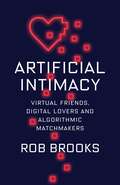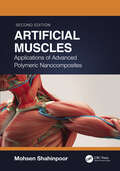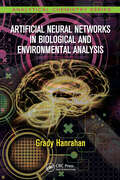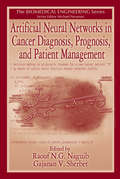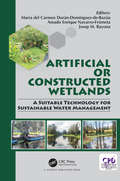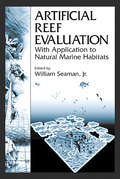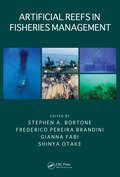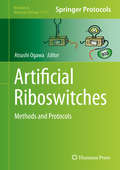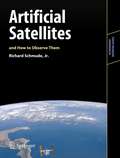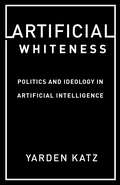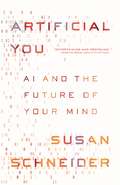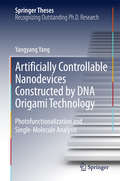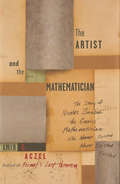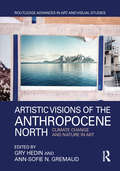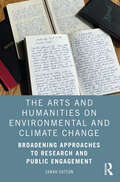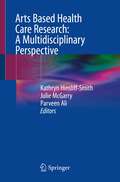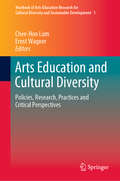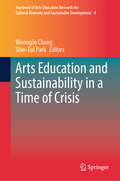- Table View
- List View
Artificial Intelligence Technologies for Computational Biology
by Ranjeet Kumar Rout Saiyed Umer Sabha Sheikh Amrit Lal SangalThis text emphasizes the importance of artificial intelligence techniques in the field of biological computation. It also discusses fundamental principles that can be applied beyond bio-inspired computing.It comprehensively covers important topics including data integration, data mining, machine learning, genetic algorithms, evolutionary computation, evolved neural networks, nature-inspired algorithms, and protein structure alignment. The text covers the application of evolutionary computations for fractal visualization of sequence data, artificial intelligence, and automatic image interpretation in modern biological systems.The text is primarily written for graduate students and academic researchers in areas of electrical engineering, electronics engineering, computer engineering, and computational biology.This book:• Covers algorithms in the fields of artificial intelligence, and machine learning useful in biological data analysis.• Discusses comprehensively artificial intelligence and automatic image interpretation in modern biological systems.• Presents the application of evolutionary computations for fractal visualization of sequence data.• Explores the use of genetic algorithms for pair-wise and multiple sequence alignments.• Examines the roles of efficient computational techniques in biology.
Artificial Intelligence Technology in Healthcare: Security and Privacy Issues (Advances in Smart Healthcare Technologies)
by Neha Sharma Durgesh Srivastava Deepak SinwarArtificial Intelligence Technology in Healthcare: Security and Privacy Issues focuses on current issues with patients’ privacy and data security including data breaches in healthcare organizations, unauthorized access to patients’ information, and medical identity theft. It explains recent breakthroughs and problems in deep learning security and privacy issues, emphasizing current state-of-the-art methods, methodologies, implementation, attacks, and countermeasures. It examines the issues related to developing artifiicial intelligence (AI)-based security mechanisms which can gather or share data across several healthcare applications securely and privately. Features: Combines multiple technologies (i.e., Internet of Things [IoT], Federated Computing, and AI) for managing and securing smart healthcare systems. Includes state-of-the-art machine learning, deep learning techniques for predictive analysis, and fog and edge computing-based real-time health monitoring. Covers how to diagnose critical diseases from medical imaging using advanced deep learning-based approaches. Focuses on latest research on privacy, security, and threat detection on COVID-19 through IoT. Illustrates initiatives for research in smart computing for advanced healthcare management systems. This book is aimed at researchers and graduate students in bioengineering, artificial intelligence, and computer engineering.
Artificial Intimacy: Virtual Friends, Digital Lovers, and Algorithmic Matchmakers
by Rob BrooksWhat happens when the human brain, which evolved over eons, collides with twenty-first-century technology? Machines can now push psychological buttons, stimulating and sometimes exploiting the ways people make friends, gossip with neighbors, and grow intimate with lovers. Sex robots present the humanoid face of this technological revolution—yet although it is easy to gawk at their uncanniness, more familiar technologies based in artificial intelligence and virtual reality are insinuating themselves into human interactions. Digital lovers, virtual friends, and algorithmic matchmakers help us manage our feelings in a world of cognitive overload. Will these machines, fueled by masses of user data and powered by algorithms that learn all the time, transform the quality of human life?Artificial Intimacy offers an innovative perspective on the possibilities of the present and near future. The evolutionary biologist Rob Brooks explores the latest research on intimacy and desire to consider the interaction of new technologies and fundamental human behaviors. He details how existing artificial intelligences can already learn and exploit human social needs—and are getting better at what they do. Brooks combines an understanding of core human traits from evolutionary biology with analysis of how cultural, economic, and technological contexts shape the ways people express them. Beyond the technology, he asks what the implications of artificial intimacy will be for how we understand ourselves.
Artificial Life: The Quest for a New Creation
by Steven LevyBiologists, mathematicians, and computer scientists learn what computers can do when given the opportunity to "think".
Artificial Muscles: Applications of Advanced Polymeric Nanocomposites
by Mohsen ShahinpoorSmart materials are the way of the future in a variety of fields, from biomedical engineering and chemistry to nanoscience, nanotechnology, and robotics. Featuring an interdisciplinary approach to smart materials and structures, this second edition of Artificial Muscles: Applications of Advanced Polymeric Nanocomposites has been fully updated to thoroughly review the latest knowledge of ionic polymeric conductor nanocomposites (IPCNCs), including ionic polymeric metal nanocomposites (IPMNCs) as biomimetic distributed nanosensors, nanoactuators, nanotransducers, nanorobots, artificial muscles, and electrically controllable intelligent polymeric network structures. Authored by one of the founding fathers of the field, the book introduces fabrication and manufacturing methods of several electrically and chemically active ionic polymeric sensors, actuators, and artificial muscles, as well as a new class of electrically active polymeric nanocomposites and artificial muscles. It also describes a few apparatuses for modeling and testing various artificial muscles to show the viability of chemoactive and electroactive muscles. It presents the theories, modeling, and numerical simulations of ionic polymeric artificial muscles’ electrodynamics and chemodynamics and features current industrial and medical applications of IPMNCs. By covering the fabrication techniques of and novel developments in advanced polymeric nanocomposites, this second edition continues to provides an accessible yet solid foundation to the subject while stimulating further research. Key features: Fully up to date with the latest cutting-edge discoveries in the field Authored by a world expert in the subject area Explores the exciting and growing topic of smart materials in medicine Mohsen Shahinpoor is Professor of Mechanical Engineering at the University of Maine and a leading expert in artificial muscles.
Artificial Neural Networks in Biological and Environmental Analysis (Analytical Chemistry)
by Grady HanrahanOriginating from models of biological neural systems, artificial neural networks (ANN) are the cornerstones of artificial intelligence research. Catalyzed by the upsurge in computational power and availability, and made widely accessible with the co-evolution of software, algorithms, and methodologies, artificial neural networks have had a profound
Artificial Neural Networks in Cancer Diagnosis, Prognosis, and Patient Management
by R. N. G. Naguib G. V. SherbetThe potential value of artificial neural networks (ANN) as a predictor of malignancy has begun to receive increased recognition. Research and case studies can be found scattered throughout a multitude of journals. Artificial Neural Networks in Cancer Diagnosis, Prognosis, and Patient Management brings together the work of top researchers - primaril
Artificial or Constructed Wetlands: A Suitable Technology for Sustainable Water Management
by María del Durán-Domínguez-de-Bazúa Amado Enrique Navarro-Frómeta Josep M. BayonaArtificial or constructed wetlands are an emerging technology particularly for tropical areas with water scarcity. For big cities, the sustainable management of water resources taking into account proper use is always challenging. The book presents case studies illustrating the above. As plants and microorganisms are a fundamental part of the correct functioning of these systems, their contribution to the degradation of the organic matter and to the removal and transformation of the pollutant compounds present in the wastewaters is also a highlight of this book.
Artificial Reef Evaluation: With Application to Natural Marine Habitats
by William SeamanBeneath the coastal waters of the world lie thousands of artificial reefs. Some are old and retired freighters and ships that once plied the oceans of the world but now serve as habitats for marine life. Others are newer reefs that have been designed and built for specific applications. With the field of aquatic habitat technology continually growi
Artificial Reefs: Marine and Freshwater Applications
by Frank M. D'itriIn this book fisheries biologists, ecologists, limnologists, oceanographers, aquatic resource managers and planners, commercial fisherman and environmental scientists are offered information on the latest artificial fishing reef designs, siting and placement methods, and ecological research as well as an overview of current united states legislation and regulations.
Artificial Reefs in Fisheries Management (CRC Marine Biology Series)
by Stephen A. Bortone Frederico Pereira Brandini Gianna Fabi Shinya OtakeWhile artificial reefs may have much to offer, they remain an anecdote in the greater scheme of fisheries management, primarily due to the lack of data specific to validating their use. Based on papers presented at the 9th Conference on Artificial Reefs and Artificial Habitats (CARAH) and also including original articles written for this reference,
Artificial Riboswitches: Methods and Protocols (Methods in Molecular Biology #1111)
by Atsushi OgawaArtificial riboswitches and other ligand-responsive gene regulators make it possible to switch protein synthesis ON or OFF with arbitrary ligand molecules. Artificial Riboswitches: Methods and Protocols focuses on the state-of-the-art methods developed in recent years for creating artificial riboswitches, therefore this volume could be regarded as a collection of recipes for the gene circuit elements in synthetic biology and metabolic engineering. Chapters cover topics such as screening or rational design methods for obtaining artificial riboswitches that function in either bacterial or eukaryotic translational systems, protocols for evaluating the activities of the resultant riboswitches, as well as protocols for construction of ligand-dependent, trans-acting gene regulators. Written in the successful Methods in Molecular Biology series format, chapters include introductions to their respective topics, lists of the necessary materials and reagents, step-by-step, readily reproducible protocols, and notes on troubleshooting and avoiding known pitfalls. Authoritative and easily accessible, Artificial Riboswitches: Methods and Protocols seeks to serve not only bioengineers who aim to reprogram cell behaviors and molecular biologists who leverage these regulators for genetic studies, but to all researchers interested in this fascinating field.
Artificial Satellites and How to Observe Them (Astronomers' Observing Guides)
by Richard Schmude Jr.Every amateur astronomer - and many non-astronomers - will be familiar with seeing a "star" that shows that characteristic steady slide across the starry background of the sky. Artificial satellites can be seen any night, and some as bright as the planets. But how many of us can identify which satellites or spent launch vehicle casing we are seeing? Artificial Satellites and How to Observe Them describes all the different satellites that can be observed without optical aid, including of course the International Space Station and the many spy satellites operated by different nations. Richard Schmude looks at them in detail and describes how they can be observed by amateurs, how to recognize them, and even how to predict their orbits. Artificial satellites have changed since the beginning of the millenium. Several additional countries have launched them. And amateur astronomers have utilized digital cameras in order to image satellites to a resolution of about three feet. This book describes how to recognize, observe, and image satellites. Examples of recent images and how they were made are given. It also offers up-to-date descriptions of the many satellites that are orbiting the Earth and other celestial bodies. Readers can learn how satellites impact our day-to-day lives. In short, Artificial Satellites and How to Observe Them is a detailed and up-to-date overview of artificial satellites and how to study them in the night sky.
Artificial Whiteness: Politics and Ideology in Artificial Intelligence
by Yarden KatzDramatic statements about the promise and peril of artificial intelligence for humanity abound, as an industry of experts claims that AI is poised to reshape nearly every sphere of life. Who profits from the idea that the age of AI has arrived? Why do ideas of AI’s transformative potential keep reappearing in social and political discourse, and how are they linked to broader political agendas?Yarden Katz reveals the ideology embedded in the concept of artificial intelligence, contending that it both serves and mimics the logic of white supremacy. He demonstrates that understandings of AI, as a field and a technology, have shifted dramatically over time based on the needs of its funders and the professional class that formed around it. From its origins in the Cold War military-industrial complex through its present-day Silicon Valley proselytizers and eager policy analysts, AI has never been simply a technical project enabled by larger data and better computing. Drawing on intimate familiarity with the field and its practices, Katz instead asks us to see how AI reinforces models of knowledge that assume white male superiority and an imperialist worldview. Only by seeing the connection between artificial intelligence and whiteness can we prioritize alternatives to the conception of AI as an all-encompassing technological force.Bringing together theories of whiteness and race in the humanities and social sciences with a deep understanding of the history and practice of science and computing, Artificial Whiteness is an incisive, urgent critique of the uses of AI as a political tool to uphold social hierarchies.
Artificial You: AI and the Future of Your Mind
by Susan SchneiderA sober-minded philosophical exploration of what AI can and cannot achieveHumans may not be Earth’s most intelligent beings for much longer: the world champions of chess, Go, and Jeopardy! are now all AIs. Given the rapid pace of progress in AI, many predict that it could advance to human-level intelligence within the next several decades. From there, it could quickly outpace human intelligence. What do these developments mean for the future of the mind?In Artificial You, Susan Schneider says that it is inevitable that AI will take intelligence in new directions, but urges that it is up to us to carve out a sensible path forward. As AI technology turns inward, reshaping the brain, as well as outward, potentially creating machine minds, it is crucial to beware. Homo sapiens, as mind designers, will be playing with "tools" they do not understand how to use: the self, the mind, and consciousness. Schneider argues that an insufficient grasp of the nature of these entities could undermine the use of AI and brain enhancement technology, bringing about the demise or suffering of conscious beings. To flourish, we must grasp the philosophical issues lying beneath the algorithms.At the heart of her exploration is a sober-minded discussion of what AI can truly achieve: Can robots really be conscious? Can we merge with AI, as tech leaders like Elon Musk and Ray Kurzweil suggest? Is the mind just a program? Examining these thorny issues, Schneider proposes ways we can test for machine consciousness, questions whether consciousness is an unavoidable byproduct of sophisticated intelligence, and considers the overall dangers of creating machine minds.
Artificially Controllable Nanodevices Constructed by DNA Origami Technology: Photofunctionalization and Single-Molecule Analysis (Springer Theses)
by Yangyang YangIn this book, the author deals mainly with two topics: (1) single-molecule visualization of switching behaviors in the DNA nanoframe system utilizing different kinds of molecular switches through the use of high-speed atomic force microscope (AFM); (2) construction of photocontrollable DNA nanostructures in programmed patterns and direct visualization of the dynamic assembling process. Here, high-speed AFM was employed to observe the dynamic movements of single molecules. Compared to a traditional single-molecule analysis method, such as fluorescence spectroscopy or electron microscopy, high-speed AFM makes possible the real-time observation of molecule behaviors. DNA nanostructures were designed and assembled as scaffolds to incorporate interested biomolecules. The observations were carried out under robust conditions without complicated pretreatment. Moreover, the photoresponsive molecules were successfully assembled into around 100 nm-sized DNA nanostructures. The assembly/disassembly of nanostructures can be regulated reversibly by photoirradiation. This book explains how DNA origami has gradually become a useful tool for the investigation of biochemical interactions in defined nanospace. It also shows the possibility of DNA nanostructures acting as nanodevices for application in biological systems, serving as a good introduction to basic DNA nanotechnology.
The Artist and the Mathematician
by Amir AczelNicolas Bourbaki, whose mathematical publications began to appear in the late 1930s and continued to be published through most of the twentieth century, was a direct product as well as a major force behind an important revolution that took place in the early decades of the twentieth century that completely changed Western culture. Pure mathematics, the area of Bourbaki's work, seems on the surface to be an abstract field of human study with no direct connection with the real world. In reality, however, it is closely intertwined with the general culture that surrounds it. Major developments in mathematics have often followed important trends in popular culture; developments in mathematics have acted as harbingers of change in the surrounding human culture. The seeds of change, the beginnings of the revolution that swept the Western world in the early decades of the twentieth century -- both in mathematics and in other areas -- were sown late in the previous century. This is the story both of Bourbaki and the world that created him in that time. It is the story of an elaborate intellectual joke -- because Bourbaki, one of the foremost mathematicians of his day -- never existed.
Artistic Visions of the Anthropocene North: Climate Change and Nature in Art (Routledge Advances in Art and Visual Studies)
by Gry Hedin Ann-Sofie N. GremaudIn the era of the Anthropocene, artists and scientists are facing a new paradigm in their attempts to represent nature. Seven chapters, which focus on art from 1780 to the present that engages with Nordic landscapes, argue that a number of artists in this period work in the intersection between art, science, and media technologies to examine the human impact on these landscapes and question the blurred boundaries between nature and the human. Canadian artists such as Lawren Harris and Geronimo Inutiq are considered alongside artists from Scandinavia and Iceland such as J.C. Dahl, Eija-Liisa Ahtila, Toril Johannessen, and Björk.
Arts and Health Promotion: Tools and Bridges for Practice, Research, and Social Transformation
by J. Hope Corbin Mariana Sanmartino Emily Alden Hennessy Helga Bjørnøy UrkeThis open access book offers an overview of the beautiful, powerful, and dynamic array of opportunities to promote health through the arts from theoretical, methodological, pedagogical, and critical perspectives. This is the first-known text to connect the disparate inter-disciplinary literatures into a coherent volume for health promotion practitioners, researchers, and teachers. It provides a one-stop depository for using the arts as tools for health promotion in many settings and as bridges across communities, cultures, and sectors. The diverse applications of the arts in health promotion transcend the multiple contexts within which health is created, i.e., individual, community, and societal levels, and has a number of potential health, aesthetic, and social outcomes. Topics covered within the chapters include: Exploring the Potential of the Arts to Promote Health and Social Justice Drawing as a Salutogenic Therapy Aid for Grieving Adolescents in Botswana Community Theater for Health Promotion in Japan From Arts to Action: Project SHINE as a Case Study of Engaging Youth in Efforts to Develop Sustainable Water, Sanitation, and Hygiene Strategies in Rural Tanzania and India Movimiento Ventana: An Alternative Proposal to Mental Health in Nicaragua Using Art to Bridge Research and Policy: An Initiative of the United States National Academy of Medicine Arts and Health Promotion is an innovative and engaging resource for a broad audience including practitioners, researchers, university instructors, and artists. It is an important text for undergraduate- and graduate-level courses, particularly in program planning, research methods (especially qualitative methodology), community health, and applied art classes. The book also is useful for professional development among current health promotion practitioners, community nurses, community psychologists, public health professionals, and social workers.
The Arts and Humanities on Environmental and Climate Change: Broadening Approaches to Research and Public Engagement
by Sarah SuttonThe Arts and Humanities on Environmental and Climate Change examines how cultural institutions and their collections can support a goal shared with the scientific community: creating a climate-literate public that engages with environmental issues and climate change in an informed way. When researchers, curators, and educators use the arts and humanities to frame discussions about environmental and climate change, they can engage a far wider public in learning, conversation, and action than science can alone. Demonstrating that archival and object-based resources can act as vital evidence for change, Sutton shows how the historical record, paired with contemporary reality, can create more personal connections to what many consider a remote experience: the changing climate. Providing valuable examples of museum collections used in discussions of environmental and climate change, the book shares how historic images and landscape paintings demonstrate change over time; and how documentary evidence in the form of archaeological reports, ships logs, Henry David Thoreau’s journals, and local reports of pond hockey conditions are being used to render climate data more accessible. Images, personal records, and professional documents have critical roles as boundary objects and proxy data. These climate resources, Sutton argues, are valuable because they make climate change personal and attract a public less interested in a scientific approach. This approach is underused by museums and their research allies for public engagement and for building institutional relevancy. The Arts and Humanities on Environmental and Climate Change will be most interesting to readers looking for ways to broaden engagement with environmental and climate issues. The ideas shared here should also act as inspiration for a broad spectrum of practitioners, particularly those writing, designing, and curating public engagement materials in museums, for wider research, and for the media.
Arts Based Health Care Research: A Multidisciplinary Perspective
by Kathryn Hinsliff-Smith Julie McGarry Parveen AliThis book, written by academics across a range of disciplines, including healthcare and social sciences discusses the increasing use of the arts in healthcare research, which often stems from the recognition that for some topics of investigation, or when dealing with sensitive issues, the usual qualitative or quantitative paradigms are not appropriate. While there is undoubtedly a place for such approaches, arts-based research paradigms (ABR) offers, not only additional study and data-collection tools, but also provides a new and enjoyable experience for those involved. The use of the arts as a medium to improve health and wellbeing was well documented by the World Health Organisation (WHO) in 2019, with over 3,000 studies conducted around the globe on the value of the arts in the prevention of ill health and promotion of health across the life span. This book examines how the arts, in a variety of forms, can be used by those working directly in healthcare settings as well as those involved in research across all health or patient settings. Covering a range of ABR genres, including literature (such as narrative and poetic inquiry); performance (music, dance, play building); visual arts (drawing and painting, collage, installation art, comics); and audio-visual and multimethod approaches, this user- friendly book will appeal to nurses, researchers in nursing and allied healthcare professions, as well professionals in the social sciences, psychosociology, psychology, literature and arts.
Arts Education and Cultural Diversity: Policies, Research, Practices and Critical Perspectives (Yearbook of Arts Education Research for Cultural Diversity and Sustainable Development #1)
by Chee-Hoo Lum Ernst WagnerThis peer-reviewed academic yearbook stems from the inaugural meeting of the newly formed UNESCO UNITWIN network on Arts Education Research for Cultural Diversity and Sustainable Development, held at the National Institute of Education, Singapore in April 2017. It presents international scholarly perspectives on issues related to arts education and cultural diversity in terms of: i) national and international policies; ii) terms, concepts and vocabularies; iii) current and ongoing research; and iv) best practices. The UNESCO UNITWIN is an arts education research think tank that gathers and leverages original research and critical commentaries on the arts and sustainable development from UNITWIN member states and beyond (Australia, Canada, Colombia, Germany, Hong Kong, Kenya, Korea, Israel, New Zealand, Singapore, Taiwan, the Netherlands and the United States of America).
Arts Education and Sustainability in a Time of Crisis (Yearbook of Arts Education Research for Cultural Diversity and Sustainable Development #4)
by WoongJo Chang Shin-Eui ParkThis book is a result of the 4th UNESCO-UNITWIN Symposium that took place in Seoul, Korea, on May 25 and 26, 2021. Held online for the first time due to the Covid-19 pandemic, distinguished arts management and cultural education scholars addressed a timely array of issues, including the power of arts participation to transform behavior and perceptions, inclusivity in arts education, the disruptions and opportunities of the lockdown, the power of arts creativity in broader problem solving, the role of local arts educators on the transcultural horizon, and the role of international cooperation in reconstituting vibrant national arts scenes. Encompassing visual, written, and performance arts education from primary through higher education, this book provides a unique window into the power of the arts to meet the harrowing tests we continue to face in the context of the global pandemic. The book offers a unique perspective that is both international in scope and addresses local responses to an unprecedented global pandemic with an emphasis on the Korean and East Asian context.
Arts of Living on a Damaged Planet: Ghosts and Monsters of the Anthropocene
by Anna Lowenhaupt Tsing Elaine Gan Heather Anne Swanson Nils BubandtLiving on a damaged planet challenges who we are and where we live. This timely anthology calls on twenty eminent humanists and scientists to revitalize curiosity, observation, and transdisciplinary conversation about life on earth.As human-induced environmental change threatens multispecies livability, Arts of Living on a Damaged Planet puts forward a bold proposal: entangled histories, situated narratives, and thick descriptions offer urgent &“arts of living.&” Included are essays by scholars in anthropology, ecology, science studies, art, literature, and bioinformatics who posit critical and creative tools for collaborative survival in a more-than-human Anthropocene. The essays are organized around two key figures that also serve as the publication&’s two openings: Ghosts, or landscapes haunted by the violences of modernity; and Monsters, or interspecies and intraspecies sociality. Ghosts and Monsters are tentacular, windy, and arboreal arts that invite readers to encounter ants, lichen, rocks, electrons, flying foxes, salmon, chestnut trees, mud volcanoes, border zones, graves, radioactive waste—in short, the wonders and terrors of an unintended epoch.Contributors: Karen Barad, U of California, Santa Cruz; Kate Brown, U of Maryland, Baltimore; Carla Freccero, U of California, Santa Cruz; Peter Funch, Aarhus U; Scott F. Gilbert, Swarthmore College; Deborah M. Gordon, Stanford U; Donna J. Haraway, U of California, Santa Cruz; Andreas Hejnol, U of Bergen, Norway; Ursula K. Le Guin; Marianne Elisabeth Lien, U of Oslo; Andrew Mathews, U of California, Santa Cruz; Margaret McFall-Ngai, U of Hawaii, Manoa; Ingrid M. Parker, U of California, Santa Cruz; Mary Louise Pratt, NYU; Anne Pringle, U of Wisconsin, Madison; Deborah Bird Rose, U of New South Wales, Sydney; Dorion Sagan; Lesley Stern, U of California, San Diego; Jens-Christian Svenning, Aarhus U.
The Arts of the Microbial World: Fermentation Science in Twentieth-Century Japan (Synthesis)
by Victoria LeeThe first in-depth study of Japanese fermentation science in the twentieth century.The Arts of the Microbial World explores the significance of fermentation phenomena, both as life processes and as technologies, in Japanese scientific culture. Victoria Lee’s careful study documents how Japanese scientists and skilled workers sought to use the microbe’s natural processes to create new products, from soy-sauce mold starters to MSG, vitamins to statins. In traditional brewing houses as well as in the food, fine chemical, and pharmaceutical industries across Japan, they showcased their ability to deal with the enormous sensitivity and variety of the microbial world. Charting developments in fermentation science from the turn of the twentieth century, when Japan was an industrializing country on the periphery of the world economy, to 1980 when it had emerged as a global technological and economic power, Lee highlights the role of indigenous techniques in modern science as it took shape in Japan. In doing so, she reveals how knowledge of microbes lay at the heart of some of Japan’s most prominent technological breakthroughs in the global economy. At a moment when twenty-first-century developments in the fields of antibiotic resistance, the microbiome, and green chemistry suggest that the traditional eradication-based approach to the microbial world is unsustainable, twentieth-century Japanese microbiology provides a new, broader vantage for understanding and managing microbial interactions with society.
